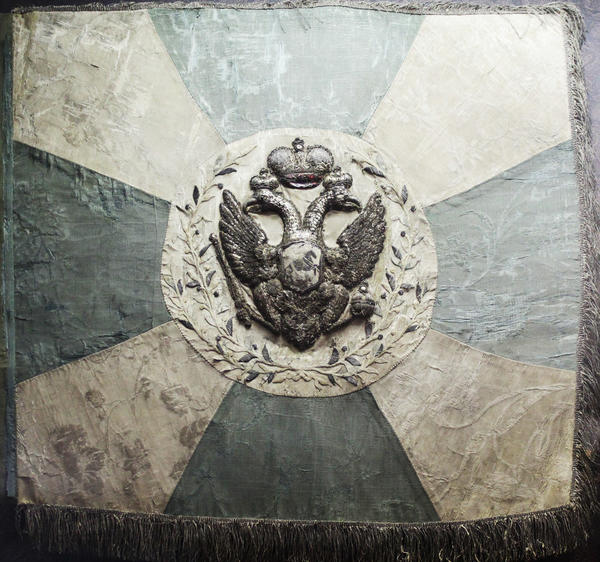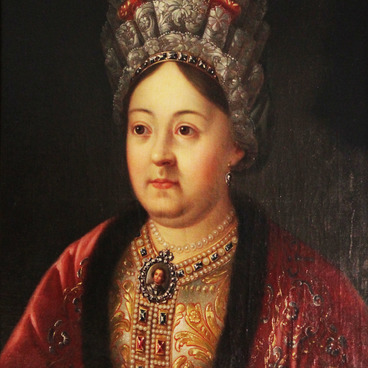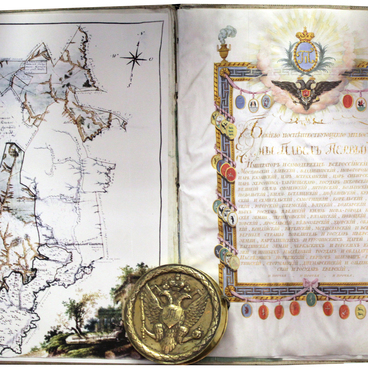The standard on view, a cavalry regiment flag, was obtained by the Tambov Ethnography Museum in 1920 as unidentified. Explorers spent a lot of time trying to discover what regiment used to own it, because both the staff and the staff ring clip had been lost. Ring clips had the name of the unit, year when the standard was granted, and the flag text.
The standard is square-shaped, 53 cm each side. It is made of patterned silk, with golden fringe at three sides. The ground consists of nine parts: four cross rays of green silk, four white corners, and a white central circle. Inside the circle, there is a wreath of green branches and a crowned two-headed eagle.
In 2002, historians found out that it is a dragoon standard dating back to 1797, the rule of Emperor Paul I. From 1797 onwards, standards would be issued only to cuirassier and dragoon regiments. As he reformed the army, the Emperor established new principles of attitudes to flags, including standards. They used to have a limited time of use, now they were supposed to be kept by regiments until completely worn and torn. Paul promoted standards from the plain organic property category to the rank of regimental sacraments. Often, he handed them in personally or had them delivered to the regiment with a special rescript, i. e. a letter with the sovereign’s personal appreciation. Each squadron of the regiment was supposed to have a standard; the colour sign of the 1st squadron, which was the patron squadron, was white and deemed to be regimental. Outdated standards would be kept in regimental arsenals or handed over to the commissariat depot, an authority in charge of army procurement.
In 2004, museum experts came up with the theory that the standard could be owned by a dragoon regiment associated with the Tambov region history in Paul I’s time: Vladimir, Yamburg, Narva, or St. Petersburg. The subsequent research found out that the Emperor granted five standards to the St. Petersburg Regiment on March 26, 1798. One of them had a white cross and green corner, the other four a green cross and white corners. All of them had a golden fringe. The experts came to the conclusion that the standard held by the Tambov Ethnography Museum belonged to the St. Petersburg Dragoon Regiment.
The standard is square-shaped, 53 cm each side. It is made of patterned silk, with golden fringe at three sides. The ground consists of nine parts: four cross rays of green silk, four white corners, and a white central circle. Inside the circle, there is a wreath of green branches and a crowned two-headed eagle.
In 2002, historians found out that it is a dragoon standard dating back to 1797, the rule of Emperor Paul I. From 1797 onwards, standards would be issued only to cuirassier and dragoon regiments. As he reformed the army, the Emperor established new principles of attitudes to flags, including standards. They used to have a limited time of use, now they were supposed to be kept by regiments until completely worn and torn. Paul promoted standards from the plain organic property category to the rank of regimental sacraments. Often, he handed them in personally or had them delivered to the regiment with a special rescript, i. e. a letter with the sovereign’s personal appreciation. Each squadron of the regiment was supposed to have a standard; the colour sign of the 1st squadron, which was the patron squadron, was white and deemed to be regimental. Outdated standards would be kept in regimental arsenals or handed over to the commissariat depot, an authority in charge of army procurement.
In 2004, museum experts came up with the theory that the standard could be owned by a dragoon regiment associated with the Tambov region history in Paul I’s time: Vladimir, Yamburg, Narva, or St. Petersburg. The subsequent research found out that the Emperor granted five standards to the St. Petersburg Regiment on March 26, 1798. One of them had a white cross and green corner, the other four a green cross and white corners. All of them had a golden fringe. The experts came to the conclusion that the standard held by the Tambov Ethnography Museum belonged to the St. Petersburg Dragoon Regiment.



